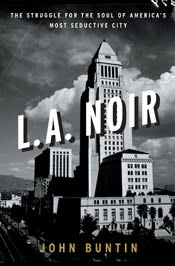John Buntin started with a real-world question steeped in fiction: how did the LAPD of L.A. Confidential become the LAPD of Dragnet? Answering it produced a rich, lively work of history that reads like a pulp novel from the era it covers.
L.A. Noir is a joint biography of William H. Parker, the chief who made the department what it is today, and Mickey Cohen, the kind of gangster who could only flourish in Southern California. But it’s also a portrait of what Buntin calls “America’s Most Seductive City” from the 1920s through the Watts riots. Like any first-rate Hollywood production it features a slew of cameos, including Billy Graham and Ben Hecht, Lana Turner and Johnny Stompanato. Some of the most interesting material involves Dragnet and how Parker used the show in all its forms to remold the LAPD’s image. It’s hard to overstate Dragnet’s popularity; at one point it was the most watched TV series in America after I Love Lucy while still drawing a huge radio audience. The next step, obviously, was a feature film. At the time of production, the LAPD’s more invasive tactics were being challenged in the courts; in instances where the department couldn’t get permission to place wiretaps, it would simply break into a suspect’s home, install a dictograph, and record conversations that way. Parker offered Dragnet’s Jack Webb a sensational case file to serve as the basis for the film, which ended up defending the techniques then under siege. The 1954 Dragnet movie, by the way, is uncommonly grim and brutal. Even for Jack Webb. It’s kind of great. It’s not currently on video, but it is available via streaming on Netflix.
Some of the most interesting material involves Dragnet and how Parker used the show in all its forms to remold the LAPD’s image. It’s hard to overstate Dragnet’s popularity; at one point it was the most watched TV series in America after I Love Lucy while still drawing a huge radio audience. The next step, obviously, was a feature film. At the time of production, the LAPD’s more invasive tactics were being challenged in the courts; in instances where the department couldn’t get permission to place wiretaps, it would simply break into a suspect’s home, install a dictograph, and record conversations that way. Parker offered Dragnet’s Jack Webb a sensational case file to serve as the basis for the film, which ended up defending the techniques then under siege. The 1954 Dragnet movie, by the way, is uncommonly grim and brutal. Even for Jack Webb. It’s kind of great. It’s not currently on video, but it is available via streaming on Netflix.
If you’re a fan of Chandler, Chinatown, or Ellroy, L.A. Noir is essential reading. It’s one of the best books of the year.
skip to main |
skip to sidebar
Twitter

Movies. Crime fiction. Baseball. Jazz. Cocktails.
MY SUBSTACK
Subscribe to Cocktails and Crime: https://vincekeenan.substack.com/
About Me
- Vince
- One-half of classic Hollywood mystery writer Renee Patrick (DESIGN FOR DYING, DANGEROUS TO KNOW, SCRIPT FOR SCANDAL, THE SHARPEST NEEDLE, IDLE GOSSIP). Tippling gadabout. Author of DOWN THE HATCH: ONE MAN'S ONE YEAR ODYSSEY THROUGH CLASSIC COCKTAIL RECIPES AND LORE, available at Amazon. Editor, the Film Noir Foundation's NOIR CITY magazine.
Email Me!
vince (at) vincekeenan (dot) com
Blog Archive
-
▼
2009
(120)
-
▼
December
(12)
- The Good Stuff: Films of 2009
- The Good Stuff: Books of 2009
- Miscellaneous: It’s A Shane Black Christmas (Redux)
- Book: Alone, by Loren D. Estleman (2009)
- Book: L.A. Noir, by John Buntin (2009)
- Book: Hollywood Moon, by Joseph Wambaugh (2009)Gaz...
- Movie: He Ran All The Way (1951)The last John Garf...
- Book: Print the Legend, by Craig McDonald (2010)Ot...
- On The Web: Crimespree CinemaThe gang over at Crim...
- Book: Ticket to Ride, by Ed Gorman (2009)I’ve read...
- Book: Losers Live Longer, by Russell Atwood (2009)...
- Movies: A Phil Karlson ThanksgivingThe Phil Karlso...
-
▼
December
(12)